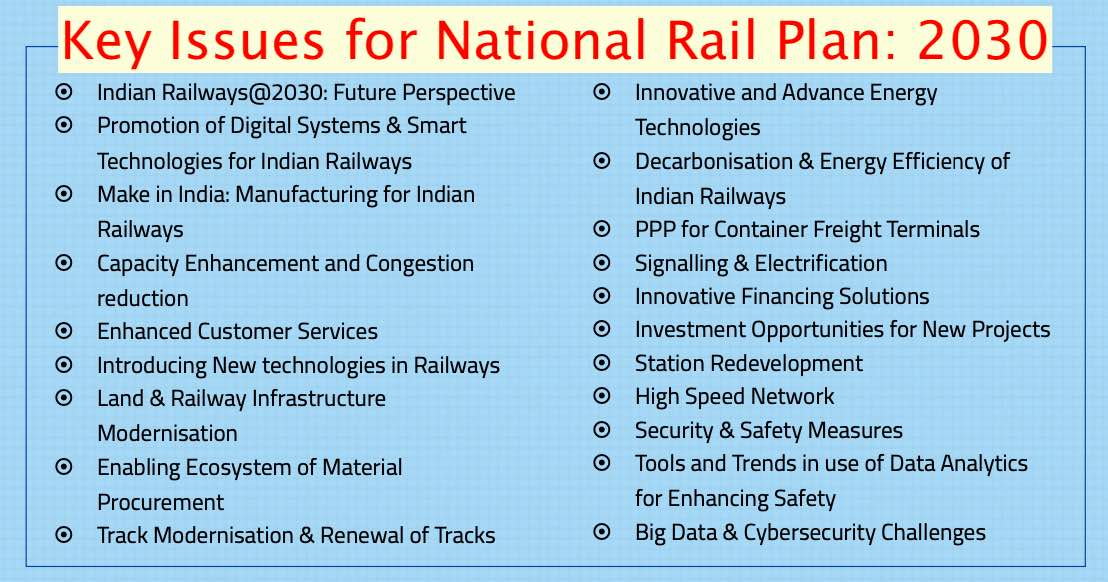Indian Railways: Vision 2024 for Infrastructure Projects, National Rail Plan

National Rail Plan (NRP), 2030
In order to provide long term perspective to planning for augmenting the railway network, in 2016, Ministry of Railways decided to develop National Rail Plan (NRP 2030) in consultation with all the stakeholders including State Governments, public representatives and other relevant Central Ministries.
Long-term Planning
The Indian Railway Network is a key component of the Country’s Transport System. Transporting goods and passengers on a massive scale, the Indian Railways plays a critical role in India’s economic as well as social fabric, not to mention the security and cross-border strategic linkages.
Indian Railways needs to form a concrete plan about its doings in the coming 10-20 years. Therefore, pragmatic development of Indian Railway Network as part of the country’s overall multi-modal transport system is very important.
Seamless multi modal transportation
NRP-2030 will endeavour to harmonise and integrate the rail network with other modes of transport and create synergy for achieving seamless multi modal transportation network across the country.

Railways do not want to beat the other modes of transport by competing but want to work by complementing.
Background:
Present way of planning
So far, the development of the rail network is taken up based on numerous individual requests received from various stakeholders such as State Governments, elected representatives, industries, etc. for sanction of railway projects in different parts of the country. Based upon these representations and based upon infrastructural gaps, operational requirements, bottlenecks strategic requirements, socio-economic considerations and participation by other stakeholders, new railway projects are sanctioned. However, these projects are sanctioned mostly in isolation and may not necessarily take holistic view of railway infrastructural needs of the Country.
· Presently Railway planning is not based on some integrated plan. Surveys are initially done as per demands of Public representatives and the some of these lines are later sanctioned. Railways shall reverse the process.
New way of Planning
· Participation of all stake holders is the key in development of NRP. Suggestions/expectations/inputs from all are needed for deliberation and inclusion in NRP. Railways are open to all ideas including any suggestion regarding how the plan should be prepared and implemented.
· Long term sustainable rail transport system- To take this process to next level, National Rail Plan 2030 has been envisaged which shall not only take care of existing corridors but also the identification and development of new corridors & connections. This will facilitate easy movement of freight and passengers, and access to resources and services with reliability, safety and convenience to secure an environmentally efficient and long term sustainable rail transport system.
· First the network plan should be there and accordingly surveys should be started. The network plan shall take into account connectivity to backward region, Congestion in the existing network and futuristic development of Industrial corridors. Deficits in existing network are to be planned for removal. There are huge regional imbalances.
· All gaps in railway infrastructure are to be identified and ways to fill them up are to be worked out. There may be surplus infrastructure in some areas whereas deficit in other areas. All gaps are to be identified and balancing of views of all the stake holders in development of plan will be important. Source
Vision 2024: Freight loading of 2024 MT in 2024
As projected in National Rail Plan (NRP), in order to improve mobility on HDN and HUN , enhance Railway network capacity and increase average speed of passenger / goods trains , important infrastructure projects have been targeted to be completed before March 2024 with the objective to achieve loading of 2024 MT in 2024.
Out of more than 68000 total route km of railway network, 34000 Route KM of Railway Network carries 96% of Traffic
| High Density Network (HDN)– | 11000 Route KM |
| Highly Utilised Network (HUN)– | 23000 Route KM |
As 34000 Route Km of Railway network comprising of 11000 Route Km High Density Network (HDN) and 23000 Route Km Highly Utilised Network (HUN) carries 96% of traffic.
Vision 2024– targets to complete various infrastructure projects before March 2024 to achieve loading of 2024 MT in 2024
Infrastructure projects to be completed before March 2024
1) Doubling of entire single line on HDN and HUN
2) Tripling /Quadrupling of 3000 RKM on HDN
3) Upgrading of speed potential of GQ / GD to 130 KMPH by December 21 and entire HDN/HUN before March 24 .
4) Upgrading speed potential of New Delhi -Mumbai and New Delhi Kolkata to 160 KMPH by March 24
5) Commissioning of Eastern and Western Dedicated Freight Corridor by June 2022
6) Identified 105 Traffic Facilities work by March 2024
7) Identified Signalling Work by March 2024
8) 51 coal connectivity projects by March 2024
9) 10 Port connectivity Projects by March 2024
10) 30 Gauge Conversion Projects of 2322 Km by March 2024
11) 146 Railway Electrification Projects by December 23.
Assured funding for these projects upto March 2024
Ministry of Railways has assured sufficient funding for these projects for 4 years ( including current year) upto March 2024. All the funding requirements have been worked out .
In due course of time, Works Directorate of Railway Board will issue details of these projects indicating targets and allocation of funds Zone wise, probably by next week.
Indian Railways is planning execution of these projects meticulously so that all these infrastructure projects are commissioned as per target .
Why Modernisation of Railways: Vision 2030
The important areas where developments in Indian Railways are needed that includes high speed trains, safety, track modernization, locomotives, signaling system and development of heavy haul system where axle loads and length of trains and usage of renewable energy for conservation of natural resources. The Government has taken some key initiatives in this direction and is also considering announcing key policy initiatives in the Railway’s network expansion, new infrastructure construction and technological up gradation.
Focus Areas for National Rail Plan: 2030
« Policy and Regulatory updates in Indian Railways
« Effective means for enhancing efficiency & safety in Indian Railways « State of the Art Technology and Joint Ventures
« Participative Models of Rail Connectivity
« Strategies to leverage private capital in Railways
« Capacity Augmentation and Infrastructure
Key issues for discussion with Stake Holders- Things to consider
The growing demand of transportation is directly related to the growth of economy, the mobility of the population and other related factors.
Indian Railways needs to form a concrete plan about its doings in the coming 10-20 years.
NRP-2030 will endeavour to harmonise and integrate the rail network with other modes of transport and create synergy for achieving seamless multi modal transportation network across the country.
- ¤ Indian Railways@2030: Future Perspective
- ¤ Promotion of Digital Systems & Smart Technologies for Indian Railways
- ¤ Make in India: Manufacturing for Indian Railways
- ¤ Capacity Enhancement and Congestion reduction
- ¤ Enhanced Customer Services
- ¤ Introducing New technologies in Railways
- ¤ Land & Railway Infrastructure Modernisation
- ¤ Enabling Ecosystem of Material Procurement
- ¤ Track Modernisation & Renewal of Tracks
- ¤ Innovative and Advance Energy Technologies
- ¤ Decarbonisation & Energy Efficiency of Indian Railways
- ¤ PPP for Container Freight Terminals
- ¤ Signalling & Electrification
- ¤ Innovative Financing Solutions
- ¤ Investment Opportunities for New Projects
- ¤ Station Redevelopment
- ¤ Security & Safety Measures
- ¤ Tools and Trends in use of Data Analytics for Enhancing Safety
- ¤ Big Data & Cybersecurity Challenges
- ¤ High Speed Network
Read more about–
- Indian Railways Policy on Development of Goods-sheds through Private Investment
- Kisan Rail: 50% Govt subsidy on transportation of fruits, vegetables by IR
- The Privatisation of Japan Railways: Why & How – a case study for IR
- Revised Organizational Structure of Railway Board
- Privatization: क्या हो रहा है रेलवे का निजीकरण ???



0 Comments